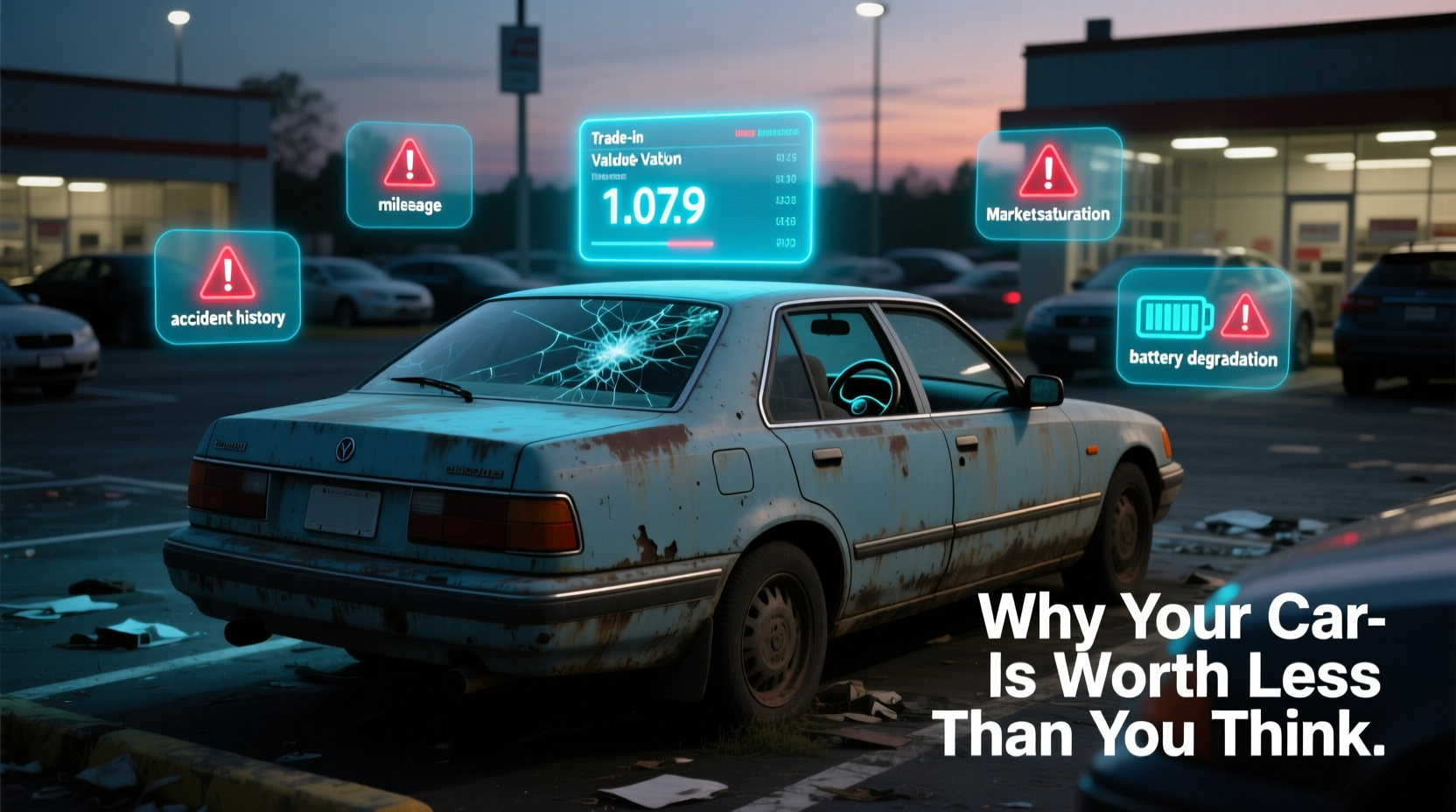Walking into a dealership expecting a fair offer for your used car only to be handed a number far below what you imagined can be jarring. You’ve kept up with maintenance, avoided major accidents, and even love the vehicle—but the trade-in appraisal feels like a gut punch. The truth is, many car owners overestimate their vehicle’s value due to emotional attachment, misinformation, or misunderstanding of how the used car market works. Understanding the real factors behind low trade-in values can help you make smarter decisions when upgrading, selling, or negotiating.
Why Your Car Loses Value So Quickly

Depreciation is the single largest factor eroding your car’s trade-in value—and it starts the moment you drive off the lot. On average, a new car loses about 20% of its value in the first year alone. By the end of three years, that figure jumps to nearly 50%. This steep drop isn’t arbitrary; it reflects market demand, production volume, and consumer preferences.
Manufacturers produce millions of vehicles annually, keeping supply high. Meanwhile, buyers often prioritize newer models with updated tech and safety features. As a result, even well-maintained older cars face downward pressure on pricing. Luxury vehicles tend to depreciate faster than economy models, despite their higher initial cost. For example, certain premium brands lose up to 60% of their value within five years, while more practical models like Honda Civics or Toyota Corollas retain value better due to reliability and strong resale demand.
Hidden Factors That Slash Trade-In Offers
Beyond mileage and age, several subtle but significant elements influence what dealers are willing to pay.
- Accident history: Even minor collisions reported on Carfax or AutoCheck reduce perceived value, as buyers worry about long-term structural integrity.
- Service records: A complete maintenance log adds trust. Missing oil changes or deferred repairs signal potential issues.
- Interior wear: Stains, torn upholstery, or heavy odor from pets or smoking can knock hundreds off an offer.
- Market saturation: If your model is common in your region (e.g., too many SUVs in suburban areas), competition drives prices down.
- Seasonal trends: Convertibles sell better in spring, while AWD vehicles gain value in winter months.
Dealers also factor in reconditioning costs—the money they’ll need to spend to clean, repair, and certify your car before reselling it. These hidden expenses directly reduce your offer.
Real Example: Sarah’s SUV Surprise
Sarah owned a 2019 Subaru Forester with 68,000 miles. She maintained it meticulously, changed the oil every 5,000 miles, and had no accidents. When she visited her local dealer for a trade-in toward a newer hybrid, she expected around $18,000 based on online valuation tools. The dealer offered $13,700.
The reason? Her model was heavily represented in inventory, reducing demand. Additionally, the interior showed noticeable wear on the driver’s seat bolster, and the tires were nearing replacement. After cleaning and minor detailing, Sarah increased the offer by $1,200 during a second negotiation—but still fell short of her expectation. This case highlights how objective metrics don’t always align with personal perception.
How Dealerships Calculate Trade-In Value
Dealers rely on proprietary systems like Black Book, Kelley Blue Book (KBB), and National Automotive Dealers Association (NADA) guides—but these are starting points, not final offers. Adjustments are made based on local market conditions, current inventory needs, and projected profit margins.
A dealership with too many compact SUVs won’t pay top dollar for another, even if it’s in great shape. Conversely, if they’re low on pickup trucks and yours fits the bill, you might get a stronger offer—even with higher mileage.
“Trade-in value isn’t just about the car—it’s about timing, location, and what the dealer needs right now.” — Mark Reynolds, Former Regional Manager at AutoNation
Do’s and Don’ts When Preparing for Trade-In
| Do | Don't |
|---|---|
| Get multiple quotes from different dealers | Rely solely on one online estimate |
| Fix small mechanical issues (e.g., check engine light) | Invest in major repairs unless highly impactful |
| Detail the interior and exterior thoroughly | Hide known problems or skip disclosure |
| Provide service records and clean title | Assume emotional value translates to monetary value |
| Negotiate the trade-in separately from the new car price | Lump everything into one “deal” without transparency |
Maximizing Your Trade-In: A Step-by-Step Guide
If you’re planning to trade in your vehicle, following a structured approach can significantly improve your return.
- Research your car’s value: Use KBB, Edmunds, and NADA to get baseline figures. Input exact trim, options, and condition.
- Inspect and repair: Address minor issues like burnt-out bulbs, cracked windshield, or worn wipers. Fix any active warning lights.
- Deep clean: Vacuum seats and carpets, wipe down surfaces, and use odor eliminators. Consider professional detailing for over $150 cars.
- Gather documentation: Collect maintenance records, owner’s manual, spare keys, and recent inspection reports.
- Get multiple offers: Visit at least 3–4 dealerships on the same day to compare bids before they adjust inventory.
- Negotiate smartly: Present competing offers and ask if they can beat them. Avoid bundling negotiations with the new car purchase until you secure a fair trade-in.
Frequently Asked Questions
Why is my car worth less than the private sale estimate?
KBB and similar sites list two values: private party and trade-in. The trade-in value is lower because dealers must account for reconditioning, certification, and profit margin. A private buyer pays more because they avoid those middleman costs.
Can I dispute a low trade-in offer?
Yes. Bring printouts of comparable listings, your service records, and evidence of recent maintenance. Polite, informed negotiation often results in a revised offer. However, understand that each dealer has internal pricing policies based on risk and demand.
Should I repair my car before trading it in?
Only if the repair increases value more than it costs. Replacing a failing alternator makes sense; repainting the entire car usually doesn’t. Focus on safety-related fixes and cosmetic flaws that scream “neglect.”
Final Thoughts: Rethinking Value Beyond Emotion
Your car may hold memories—road trips, daily commutes, family outings—but the marketplace doesn’t assign sentimental value. What matters are cold, hard metrics: depreciation curves, mechanical reliability, supply vs. demand, and presentation. Accepting this reality isn’t defeat; it’s empowerment.
By understanding the mechanics behind low trade-in values, you position yourself to act strategically rather than react emotionally. Whether you decide to sell privately, delay the upgrade, or invest in key improvements, knowledge gives you leverage.









 浙公网安备
33010002000092号
浙公网安备
33010002000092号 浙B2-20120091-4
浙B2-20120091-4
Comments
No comments yet. Why don't you start the discussion?